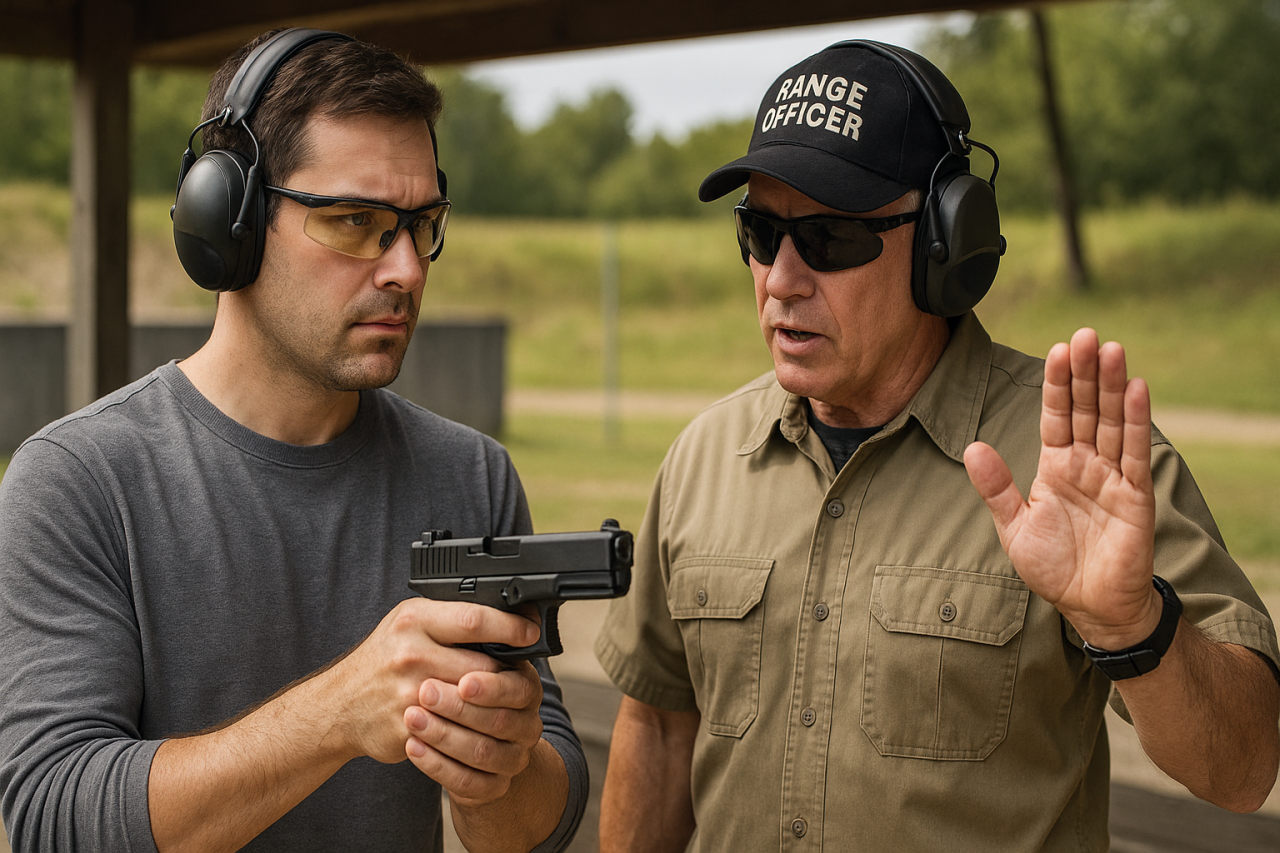Range safety officers communicate through standardized commands that every shooter must understand immediately. Whether you're planning your first shooting range visit or building advanced skills, these verbal cues ensure everyone's safety while demonstrating your competence to other shooters and range staff.
What Men's Health Issues Concern You Most?
- Immediate command recognition prevents dangerous delays that can result in range ejection or accidents
- Professional response to safety calls builds credibility with experienced shooters and range staff
- Confident command compliance allows you to focus on shooting fundamentals rather than worrying about protocols
- Proper command knowledge enables you to help less experienced friends during group outings
- Mastering range language demonstrates serious commitment to firearms safety and responsible ownership
- The Foundation Commands Every Shooter Must Master
- When Things Go Wrong: Individual Corrections
- Emergency Situations Demand Different Responses
- Timing Your Response Like a Professional
- Developing Command Recognition Before You Need It
- Understanding the Nuances of Different Range Types
- Learning From Common Command Mistakes
- Advancing Beyond Basic Commands
- Building Your Range Leadership Skills
The Foundation Commands Every Shooter Must Master
Walking into a shooting range for the first time, you'll quickly realize that communication happens through a precise verbal language designed to keep everyone alive. Range officers don't make casual suggestions - they issue commands that demand immediate response.
The most fundamental command you'll hear is "Eyes and Ears!" This isn't a request. When you hear these words, everything stops until you have your safety glasses and hearing protection properly secured. Range officers repeat this command whenever someone new arrives or when they notice unsafe equipment situations.
Once everyone is properly protected, you'll hear "Range is Hot!" - your green light to begin handling firearms. Here's what trips up most beginners: you can only touch guns when you're positioned at the firing line and this command has been given. That rifle sitting on the bench behind you? Off limits until you hear those magic words.
The flip side comes with "Range is Cold!" When this echoes across the range, everything firearm-related stops immediately. Step back from the firing line and keep your hands away from any weapons. This usually means someone needs to go downrange for target changes or maintenance.
But there's one command that supersedes everything else: "Cease Fire!" This is the emergency brake of range commands. Whether you're mid-shot or just getting comfortable, you immediately unload your firearm, open the action, place it on the bench pointing downrange, and step back. Questions come later - compliance comes now.
"Down Range!" signals that someone needs to walk forward of the firing line. Every gun gets unloaded with actions open and placed safely on benches. Think of this as creating a sterile field where no one can accidentally discharge a weapon while people are in the danger zone.
When Things Go Wrong: Individual Corrections
Even experienced shooters occasionally need correction, and range officers deliver these redirections with surgical precision. Don't take it personally - they're preventing accidents before they happen.
"Muzzle Direction!" means your barrel is pointing somewhere it shouldn't be. This happens more often than you'd think, especially during loading, unloading, or when adjusting equipment. The instant you hear this, point that muzzle downrange and keep it there.
You'll also hear "Finger Off the Trigger!" when someone gets a little too eager. Modern firearms are remarkably safe, but they will fire if you pull the trigger. Keep that finger alongside the frame until you're actually ready to shoot.
If you hear "Step Back from the Line!" - do exactly that. This usually follows a safety violation or happens during cold range procedures. Move away from your shooting position and wait for further instructions.
"Unload and Show Clear!" requires you to remove all ammunition and physically demonstrate the gun is empty. Open the action, show the chamber and magazine are clear, and wait for acknowledgment before proceeding.
Sometimes you'll get "Open Action!" which means opening your firearm's mechanism to show it's unloaded. This ensures all weapons are in safe condition during cold periods or when people go downrange.
Emergency Situations Demand Different Responses
When serious problems develop, range commands take on increased urgency that overrides normal shooting activities.
"Medical Emergency!" stops everything while someone receives immediate attention. Secure your firearms quickly but prioritize getting yourself and others to safety. Don't approach injured persons unless specifically directed by range staff.
"Evacuation!" means leave immediately through designated exits. Secure firearms if possible, but personal safety comes first. Follow staff directions for emergency procedures rather than making independent decisions.
"Malfunction!" indicates a firearm problem that requires professional help. Keep the weapon pointed downrange and call for assistance. Never attempt repairs yourself unless you have specific training for that particular malfunction.
Timing Your Response Like a Professional
Here's what separates confident shooters from obvious beginners: response speed. Range officers expect immediate compliance, not discussion or hesitation.
You've got maybe 2-3 seconds to respond to any command. That's not much time, especially when you're concentrating on your shooting or dealing with equipment. This is why mental rehearsal matters - practice visualizing your response to each command until it becomes automatic.
When possible, acknowledge commands verbally. A simple "Yes, sir" or "Understood" confirms you heard the instruction and are complying. Range officers appreciate this feedback, especially in noisy environments where they might not see your immediate response.
Save questions for after you've complied with safety commands. Range officers prioritize immediate safety over explanations during active shooting periods. Once the situation is stable, they're usually happy to explain what happened and how to prevent similar issues.
If you're bringing friends or family, especially during group outings, help others who seem confused by commands. Point out what they should do without speaking for them or interfering with range officer authority. Your assistance supports safety without undermining official procedures.
Developing Command Recognition Before You Need It
The worst time to learn range commands is when an emergency develops. Smart preparation prevents dangerous delays during actual shooting sessions.
Study command lists before visiting any range so the language becomes familiar. Many first-time shooters get overwhelmed by unfamiliar terminology during their initial experiences. A few minutes of preparation can prevent confusion and embarrassment.
Practice mental responses while reviewing commands. Visualize yourself in different scenarios - what would you do if you heard "Cease Fire!" while changing magazines? How would you respond to "Down Range!" while adjusting your target? This mental rehearsal builds automatic responses.
During range briefings, listen carefully even if you've heard similar information before. Every facility has specific procedures that may differ from other ranges you've visited. Ask for clarification on any commands that seem unclear rather than guessing during actual shooting.
Some ranges use variations on standard commands or include additional terminology based on their layout and procedures. Indoor facilities often rely more on automated systems, while outdoor ranges might emphasize different commands based on their target systems and range management approaches.
Understanding the Nuances of Different Range Types
Not every shooting facility operates exactly the same way, and recognizing these differences can prevent confusion during your visits.
Indoor ranges often rely heavily on automated target systems and environmental controls that influence which commands get used most frequently. You'll hear more emphasis on "Eyes and Ears!" because the enclosed space amplifies sound, and "Muzzle Direction!" becomes critical since any deviation can damage expensive equipment or ventilation systems.
Outdoor ranges typically provide more space and natural sound dampening, but they introduce weather considerations and varying target distances. Commands like "Down Range!" happen more frequently since manual target changes are common, and wind conditions might prompt additional safety instructions.
Private clubs sometimes incorporate membership protocols into their command structure, while public ranges focus purely on universal safety standards. Training facilities may use military-style terminology or sport-specific commands that go beyond basic range control.
Competition ranges add another layer with match-specific commands related to timing, scoring, and competitive procedures. If you plan to attend matches, expect to learn additional terminology beyond standard safety protocols.
The key is staying flexible and paying attention during each facility's orientation. When in doubt, ask questions during the briefing rather than guessing during live fire exercises.
Learning From Common Command Mistakes
Every experienced shooter has stories about command responses gone wrong, and learning from these mistakes can save you from similar embarrassment.
The classic rookie error is arguing with range officers about commands. Maybe you think your gun is pointed safely, or you believe you responded quickly enough. Here's the reality: range officers have authority regardless of your experience level or personal opinions. Compliance first, discussion later.
Another common mistake is ignoring commands directed at others when you're in similar situations. If the range officer tells someone else "Finger Off the Trigger!" and you're doing the same thing, fix your behavior immediately without waiting for personal correction.
Over-explaining your actions while complying with commands wastes time and can interfere with safety procedures. Simple compliance works better than detailed justifications about why you were doing something or what your intentions were.
Perhaps the most dangerous mistake is hesitating due to confusion about proper responses. When uncertain, stop all activity and ask for specific guidance. Range officers prefer answering questions to dealing with accidents caused by wrong guesses.
Advancing Beyond Basic Commands
Once you've mastered fundamental range commands, you'll start recognizing the subtle variations that indicate different urgency levels and situations.
Routine commands during normal operations have a standard, professional tone that maintains safe conditions without suggesting immediate danger. These keep the range running smoothly during regular shooting activities.
Urgent commands carry sharper tones that indicate developing safety concerns requiring immediate attention. React quickly and decisively to prevent these situations from escalating into emergencies.
Emergency commands demand maximum urgency and instant response regardless of what you're doing. Drop everything and comply immediately without question or delay.
Instructional commands during training sessions often allow for questions and clarification after initial compliance. These learning environments encourage interaction between students and staff once safety requirements are met.
Understanding these nuances helps you respond appropriately while supporting range operations and maintaining positive relationships with staff and other shooters.
Building Your Range Leadership Skills
Mastering range commands enables you to help others during group outings while supporting rather than undermining official authority.
When you bring friends or family to ranges, your confident response to commands encourages others and demonstrates proper behavior. Model immediate compliance and professional acknowledgment that shows newcomers how experienced shooters behave.
Quietly assist confused visitors by pointing out what they should do without speaking for them or interfering with range officer instructions. Your support helps maintain safety without challenging official procedures or creating authority conflicts.
Before group visits, prepare your guests by explaining common commands and expected responses. This preparation prevents confusion and embarrassment while ensuring everyone understands the serious nature of range safety.
Reinforce that safety always takes priority over fun or performance. Your attitude influences your group's behavior and demonstrates that responsible shooting requires constant attention to protocols and procedures.
Mastering range commands forms the foundation for all successful shooting experiences. Whether you're developing personal skills or leading group outings, professional command response demonstrates your commitment to safety while building credibility with range staff and experienced shooters. These communication skills enhance every aspect of your involvement in shooting sports.
For more comprehensive shooting range preparation, including gear selection and safety protocols, check out our complete first-time shooting range guide.
Hey James Hills wants you to share this!

